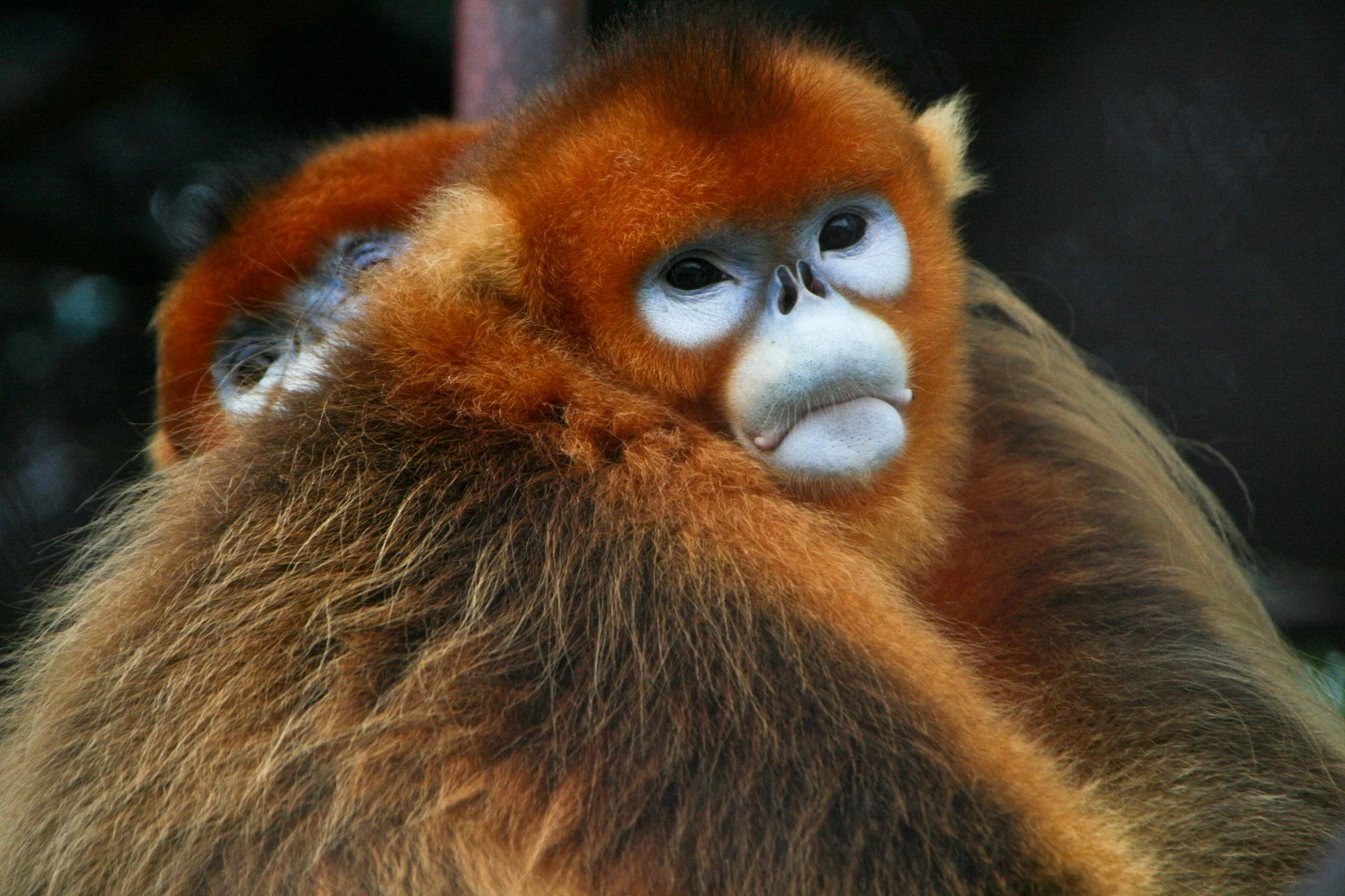The Creature Feature: 10 Fun Facts About the Golden Snub-Nosed Monkey
Giovanni Mari, via Wikimedia Commons.
In the mountains of central and southwestern China, along the Tibetan Plateau, lives an unusual primate: the golden snub-nosed monkey (Rhinopithecus roxellana). The species name roxellana refers to a concubine of Suleiman the Magnificent, a 16th century Sultan of the Ottoman Empire. She was known for her golden-red hair and, purportedly, her upturned nose.
But it’s more than just their looks that make golden snub-nosed monkeys unique. Read on to get to know these primates better.
1. Golden snub-nosed monkeys can withstand the coldest temperatures of any nonhuman primate. These monkeys live in temperate, mountaintop forests, sometimes at altitudes over 6,000 feet (3,000 m) above sea level. Here, temperatures can drop as low as 17°F (−8.3°C) and snow covers the ground from December to March.
2. Their lives vary with the seasons. Though they cope well with low temperatures, golden snub-nosed monkeys sometimes migrate to slightly lower elevations during the winter. They are foragers, and their diet varies according to the season. The monkeys feed primarily on leaves and pine needles in the warm summer months, supplemented by fruits, flowers, seeds, and the occasional invertebrate. In the winter, their diet consists mostly of bark and lichen.
The monkeys’ coats change with the seasons, too. They transition from a duller brown color in the summer to a bright orange coat with longer, thicker hair for the cold winter months.
3. Golden snub-nosed monkeys have a striking appearance from head to tail. Let’s start with that face. Surrounding the round, black eyes of these monkeys is pale blue skin, which fades to a whitish-gray color around their hairless muzzles. Their eponymous noses are completely flattened with forward-facing nostrils.
On the other end, golden snub-nosed monkeys possess tails that can grow longer than the length of the rest of their bodies. They use these non-prehensile tails to help them balance.
4. The males are showier than the females. Adult male golden snub-nosed monkeys are larger than females; males weigh around 43 pounds (19.8 kg), while females average around 27 pounds (12.4 kg). Males are also brighter in color, with the amount of orange in their coats increasing as they age.
In addition, male golden snub-nosed monkeys have wart-like growths at the corners of their mouths, a unique feature among primates whose function has not been studied. Finally, the bright blue-white scrotum and black penis of the males can help differentiate the sexes.
PieCam, via Wikimedia Commons.
5. Golden snub-nosed monkeys are at home in the trees. These monkeys spend almost all their time in the trees — that’s where the food is and the predators aren’t. They move from tree to tree by walking on all fours, leaping, and swinging from one branch to another.
6. They form complex, multilevel societies. Golden snub-nosed monkeys are highly sociable and live in “fission-fusion” societies. In this kind of social structure, individuals form large groups and split into smaller groups over time. (Some other animals with fission-fusion societies are elephants, dolphins, great apes, and humans.)
In the spring and summer, golden snub-nosed monkeys gather in groups of as many as 600 individuals. With the advent of cold weather, they break into subgroups typically consisting of an adult male, several adult females, and their offspring.
7. Females initiate mating by signaling their interest. Golden snub-nosed monkeys have a polygynous mating system, meaning the females of a group all mate with the same, single male. During the three-month breeding season, female monkeys have a few ways to show the male their readiness. They may lock eyes with the male and then scamper a short distance away. They may also strike a pose by hanging their heads down, curling their legs up, and pointing their nether region in his direction.
Males respond to these signals by opening their mouths wide and, if interested (which is only about half the time), mounting the female.
Jack Hynes, via Wikimedia Commons.
8. Female golden snub-nosed monkeys nurse and adopt others’ infants. Over a five-year period, researchers observed that more than 87% of golden snub-nosed monkey infants were nursed by females other than their mothers. The findings, published in 2019, were the first evidence of this phenomenon in an Old World monkey (those native to Asia and Africa).
In 2024, researchers reported on a case in which one female golden snub-nosed monkey adopted an unrelated infant (another behavior that is rare or nonexistent in Old World monkeys). The female had an infant of her own — but it was sired by the dominant male of another group and thus was at risk of being killed by her own group’s dominant male. The infant she adopted was the offspring of her dominant male and a female in another group. Adopting an infant genetically linked to her group’s male was a clever strategy. It may have helped strengthen her relationship with the male and protect her own offspring from infanticide.
9. These monkeys are chatty. Golden snub-nosed monkeys use at least 18 different types of vocalizations, including whines, grunts, coos, chucks, and shrills (squeaks and squeals uttered by females in response to male whines). Weirdly, they can produce some of these calls without any accompanying body or facial movement. This ventriloquist-like behavior is especially apparent when males and females exchange whines and shrills while eating.
10. Golden snub-nosed monkeys are one of the world’s 25 most endangered primates. This fact is less fun, but it’s important. The total worldwide population of these endangered monkeys is estimated to be as many as 20,000 individuals to as few as 8,000. Golden snub-nosed monkeys are built for trees and snowy winters; deforestation and climate change seriously threaten their survival.
References and Further Reading:
Cerrone M. 2024. “Golden Snub-Nosed Monkey: Rhinopithecus roxellana.” New England Primate Conservancy. https://neprimateconservancy.org/golden-snub-nosed-monkey/.
Gron KJ. 2007 November 20. “Primate Factsheets: Golden snub-nosed monkey (Rhinopithecus roxellana) Taxonomy, Morphology, & Ecology.” Wisconsin National Primate Research Center. https://primate.wisc.edu/primate-info-net/pin-factsheets/pin-factsheet-golden-snub-nosed-monkey/.
Munoz P. 1999. "Rhinopithecus roxellana,” Animal Diversity Web. https://animaldiversity.org/accounts/Rhinopithecus_roxellana/
Xiang Z, Fan P, Chen H, Liu R, Zhang B, Yang W, Yao H, Grueter CC, Garber PA, Li M. 2019. Routine allomaternal nursing in a free-ranging Old World monkey. Sci Adv. 5(2):eaav0499. DOI: 10.1126/sciadv.aav0499.
Zhao H, Li J, Wang Y, Li N, Pan R, and Li B. 2024. A Unique Case of Adoption in Golden Snub-Nosed Monkeys. Animals, 14. DOI: https://doi.org/10.3390/ani14213075.



